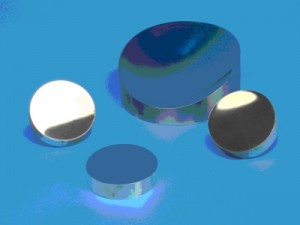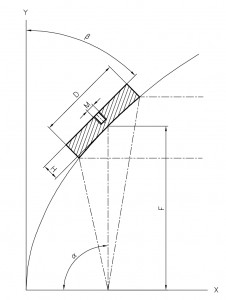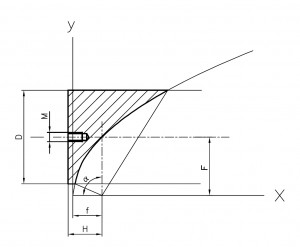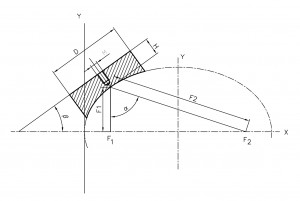 Off-axis paraboloid reflectors are a circular segment from one side of a full paraboloid. The focal point is off the mechanical axis, giving full access to the reflector focus area.
Off-axis paraboloid reflectors are a circular segment from one side of a full paraboloid. The focal point is off the mechanical axis, giving full access to the reflector focus area.
Unlike standard parabolic mirrors, these mirrors direct and focus incident collimated light at a specific angle (for example 60 or 90 degrees) , allowing unrestricted access to the focal point.
Our off-axis metal parabolic mirrors focus or direct incident collimated light at 90°. Protected gold coatings are available for different applications.
Each mirror is machined flat on the back and has tapped center hole for mounting.

Fig.1 Off-axis paraboloidal mirror Fig.2 Off-axis paraboloidal mirror
Fig.2 Off-axis paraboloidal mirror
Available are following 90° off-axis paraboloidal mirrors (dimensions in mm):
| D | F | à | ß | H | Thread | Coating |
| 42 | 160 | 90 | 45 | 8 | M4 | Au |
| 42 | 80 | 90 | 45 | 8 | M4 | Au |
| 40 | 25 | 90 | 0 | 12 | M4 | Au |
| 28 | 80 | 90 | 0 | 14 | M3 | Au |
| 28 | 60 | 90 | 0 | 14 | M3 | Au |
| 28 | 25 | 90 | 0 | 12 | M3 | Au |
Ellipsoidal reflectors have two conjugate foci. Light from one focus passes through the other, after reflection. Ellipsoids collect a much higher fraction of total emitted light than a spherical mirror.
Because ellipsoidal reflectors can enhance light collection without dramatically increasing heat in the illumination plane, they are an ideal selection for many projection and general illumination applications. 
Fig.3 Off-axis ellipsoidal mirror
Available are following off-axis ellipsoidal mirrors (dimensions in mm):
| D | F1 | F2 | à | ß | H | Thread | Coating |
| 50 | 37 | 256 | 80 | 81 | 20 | M4 | Au |
| 42 | 25 | 80 | 72 | 36 | 8 | M4 | Au |
| 42 | 25 | 160 | 81 | 41 | 8 | M4 | Au |
| 28 | 25 | 60 | 65 | 65 | 10 | M3 | Au |
| 28 | 25 | 25 | 90 | 0 | 8 | M3 | Au |
